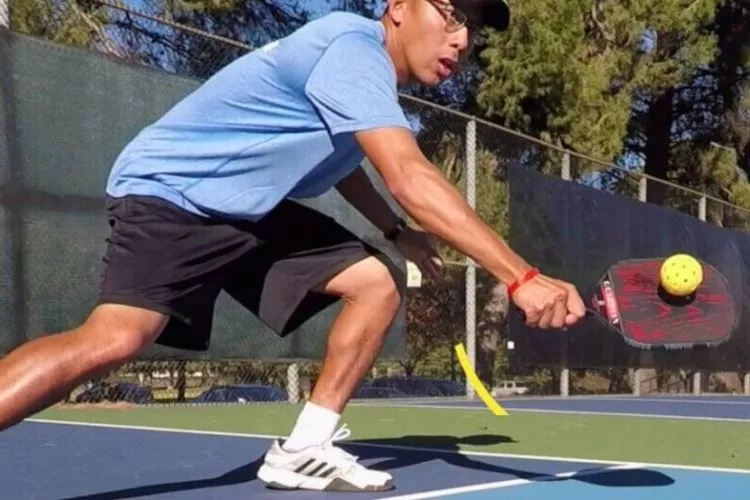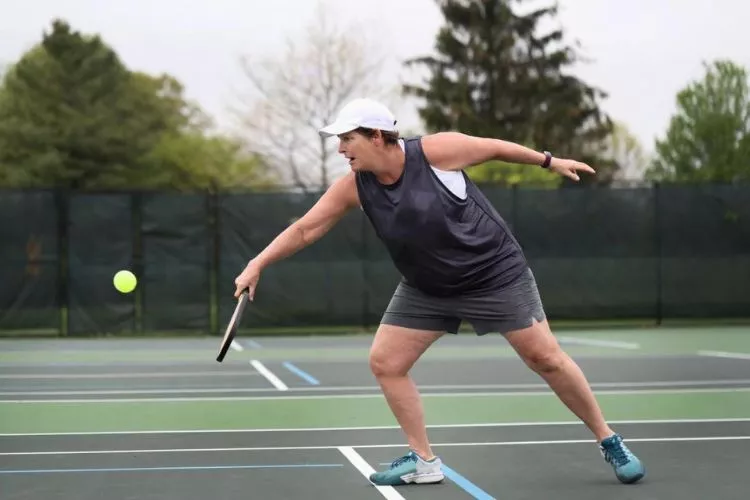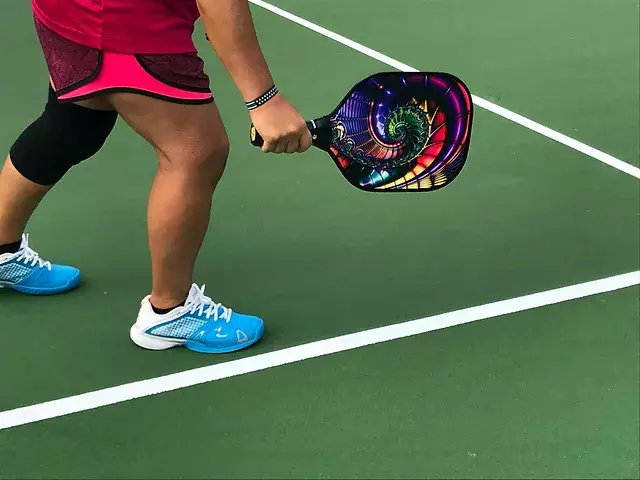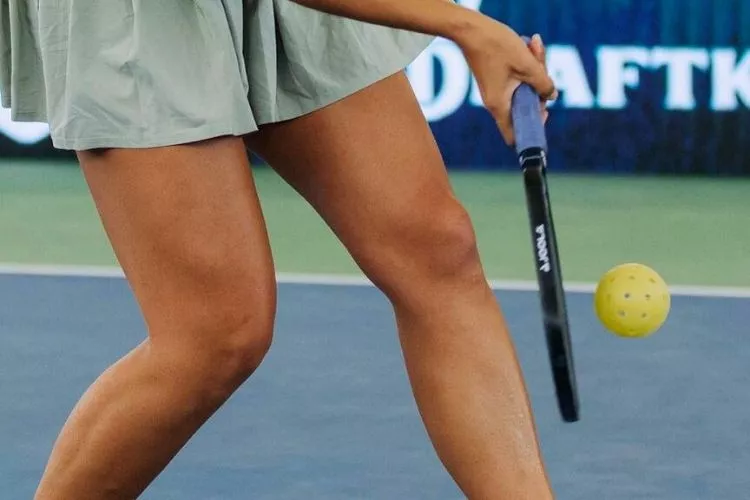Great skill in pickleball is not solely defined by powerful slams or quick dashes; oftentimes, it’s the subtler, more tactical maneuvers that separate the novices from the seasoned players.
One such technique, notoriously difficult yet remarkably effective, is the ‘dink shot.’
If you learn how to master the dink shot, then you can truly elevate your game, rendering you a formidable opponent on the pickleball court.

This article aims to provide an authoritative, step-by-step guide on how to cultivate and perfect this highly efficient shot, covering all aspects from its foundational principles to advanced strategies.
Whether you’re a casual player looking to add a new skill to your repertoire or a dedicated enthusiast seeking to enhance your game strategy, mastering the art of the dink shot can be a game-changer in your pickleball journey.
How to Master the Dink Shot in Pickleball?
Pickleball, a game of strategy and precision, has a secret weapon that can often turn the tide of the match: the dink shot.
Let’s plunge into this comprehensive guide designed to help you with mastering this move, thereby refining your gameplay.
Understanding the Dink Shot
A ‘dink shot,’ mainly a soft shot, is played barely over the net and drops into the non-volley zone. This technique aims to keep your opponent close to the net, decreasing their shot angles and potentially forcing a mistake.
While it may seem simple, performing an effective dink shot requires a proper understanding, finesse, practice, and perfect timing.
Techniques to Master the Dink Shot
- Grip and Posture: Firstly, the right grip is key to control and pace. Hold your paddle like you are shaking someone’s hand, allowing a range of wrist motions for a successful dink. For consistent shots, maintain a slightly bent posture, relax your grip for soft hits, and keep your eye on the ball till you hit, ensuring accuracy.
- Shot Placement: Effective dink shots are ideally played cross-court. This method not only gives the ball more space to drop into but also makes it more challenging for the opponent to make the shot due to increased travel distance.
- Paddle Face: To affect the ball’s speed and direction, pay attention to the paddle’s face during the hit. For a perfect dink shot, the paddle face should be slightly open and the ball should be hit below the center, allowing it to just cross the net.
- Use of Wrists: Understanding the shot’s rhythm is essential. Dink shot requires more wrist than arm action. Relax your wrist to maintain the soft touch needed for a dink, as tense wrists often lead to misdirected or overpowering shots.
Strategy
While the technical aspects of the dink shot are vital, understanding when to deploy this tactic can make it even more effective.
- Patient Gameplay: Dink shots are all about patience. These shots keep your opponent at the net, and if performed correctly, compel them to hit the ball upward, providing you with a chance to attack.
- Transition Phase: This shot works best in the transition phase when the opponent moves from the baseline to the non-volley line. It forces them to either take a risky volley or let it bounce, giving you time to take the offensive position at the net.
- Majority Rule: Remember, dink shots are not always about winning points. More often, they are strategic maneuvers, performed to maintain control, keep opponents off balance, and set you up for a winning shot.
Practice
There’s a saying – practice makes perfect, and perfect practice makes permanent. So, in your journey to mastering the dink shot, invest time in deliberate practice.
Start with various drills, like cross-court dinks, straight-on dinks, and team dinks. Aim for at least 30 minutes of focused practice sessions on your dink shots per day.
Pickleball’s beauty lies in its versatility, and mastering the dink shot is all about incorporating this range into your gameplay.
It may initially seem challenging, but with patience, practice, and attention to detail, you will see your game improve significantly. So, equip yourself with your paddle, get on the court, and start honing your dink shot skills today.
Common Mistakes and How to Avoid Them
Dink shots are essential weapons in any pickleball player’s toolkit, but they can be tricky to master.
Here, we will explore some common mistakes players make when attempting dink shots and offer tips on how to prevent and rectify these pitfalls.

Mistake 1: Hitting the Ball Too Hard
Solution: Practice control and finesse when executing dink shots, as hitting the ball with excessive force can lead to it landing out of bounds or providing your opponent an opportunity for an aggressive shot. Focus on adopting a soft, relaxed grip and smooth, controlled wrist movement to ensure the shot stays low and barely clears the net.
Mistake 2: Improper Footwork
Solution: Good footwork is vital for executing an effective dink shot. Poor footwork can cause you to lose balance, hit the ball out of position, or even hinder your movement to reach the next shot. Pay attention to your foot positioning, advance towards the ball, and maintain agility and balance for optimal execution.
Mistake 3: Incorrect Paddle Face Angle
Solution: The position of the paddle face at the moment of contact with the ball greatly influences the shot outcome. If the angle is wrong, the ball may not clear the net or might lift too high, making it an easy target for your opponent. To remedy this, aim for a slightly open paddle face and direct the ball just over the net with a gentle stroke.
Mistake 4: Focusing on Power Rather Than Placement
Solution: Unlike power shots, dink shots are more about precise placement and keeping the ball low. Concentrate on the shot’s trajectory, targeting the front edge of your opponent’s non-volley zone. This precision will limit their angles and force them into a defensive position.
Mistake 5: Poor Ball Contact Timing
Solution: Striking the ball at the right moment can be the difference between a successful dink and a missed opportunity. Hitting too early or too late can result in a weak shot or unintended direction. Practice your timing, ideally hitting the ball at the top of its bounce, to ensure consistency and precision.
Mistake 6: Overusing the Dink Shot
Solution: Relying excessively on dink shots may make your game predictable, allowing opponents to adapt and exploit your one-dimensional strategy. Mix up your shots to keep your opponents guessing and use dink shots wisely, integrating them into different combinations to maximize their effectiveness.
Mistake 7: Neglecting Court Positioning
Solution: One of the critical aspects of dink shot success is being aware of where you are on the court. Poor positioning can lead to exposure to aggressive shots or limit your available response options. Be proactive in maintaining good court positioning to safely execute dink shots and prepare for any incoming attacks.
By understanding these common errors and learning to prevent or rectify them, you can refine your dink shot technique and become a more formidable pickleball player. Practice diligently, applying these tips, and watch as your dink shot mastery propels your game to new heights.
The Role of Footwork in Executing Effective Dink Shots: A Detailed Overview
Footwork in pickleball is just as crucial as the strokes themselves. Especially when it comes to executing an effective dink shot, your footwork can make a tremendous difference.
This guide will delve into the significance of proper footwork and provide tips to improve your movement on the court.

Significance of Proper Footwork
- Positioning and Balance: Acquiring the right position before executing a shot is pivotal. Proper footwork allows you to maintain balance, which is crucial in dink shots where you need a controlled, soft shot just over the net.
- Shot Accuracy: Your accuracy in hitting the ball is significantly influenced by footwork. Good footwork can help get your body and paddle in the optimal spot to execute a precise shot.
- Swift Recovery: Rapid response to the opponent’s shots is part of pickleball strategy. Fast, efficient footwork allows you to recover and prepare for the next shot quickly.
- Reduces Physical Stress: Efficient footwork reduces the amount of unnecessary running on the court. It helps in maintaining energy levels throughout the game and reduces the risk of physical stress and injury.
Tips to Improve Your Movement on the Court
- Practice Lateral Movements: Lateral quickness is essential in pickleball. Incorporate lateral movement drills into your training routine to improve your side-to-side agility.
- Front and Back Movement Training: Include forward and backward running in your practice to enhance your quickness and ability to cover the court more effectively.
- Proactive Footwork: Always be on your toes to react quickly and move preemptively based on your opponent’s position and potential shot direction.
- Split-step Technique: Use the split-step technique – a small hop just before your opponent hits the ball. It initiates forward momentum and allows you to react swiftly in any direction.
- Conditioning Exercises: Regular fitness routines or sports conditioning exercises can improve your overall agility and endurance, enhancing your footwork over time.
- Use of Non-Dominant Foot: Practice using your non-dominant foot to pivot and push off when making lateral movements. This can provide balance, power and enable quick direction changes.
- Shadow Playing: Playing out rallies without a ball (shadow playing) allows you to focus solely on your footwork and movement around the court.
Remember, improvement in footwork doesn’t happen overnight. It requires persistence and regular practice. Incorporating these tips and drills in your training sessions should, over time, significantly improve your dink-shot execution and overall pickleball gameplay.
Advanced Dink Shot Techniques: Elevating Your Pickleball Game
Once you have mastered the basics, it’s time to explore advanced dink shot techniques to elevate your pickleball game.
By incorporating pace changes, spin variations, and deceptive shots, you’ll be able to create more opportunities on the court and keep your opponents guessing. Let’s discuss these techniques in detail.

Changing Pace
Incorporating different dink shot speeds can frustrate your opponents and force errors. For instance, hitting some dinks with a slower pace makes your opponent’s movements less efficient, requiring them to adjust their position and timing. On the other hand, speeding up your dink shot occasionally may catch your opponent off guard, leading to a weak return.
Tips:
- Practice varying your dink shot speed during rallying exercises.
- Observe how your opponents respond to the change in pace and exploit their weaknesses.
- Aim for precision with every shot, whether fast or slow.
Spin Variations
Adding spin to your dink shots can further confuse your opponents by changing the ball’s trajectory and making it challenging to return. There are two primary spins to consider: topspin and backspin.
- Topspin: This spin involves brushing up the back of the ball, causing it to dip faster over the net and bounce higher. Topspin dinks require your opponent to judge their response more accurately, increasing the potential for errors.
- Backspin: By sliding your paddle from high to low, you can generate a backspin dink. It causes the ball to bounce lower and might even roll backward, forcing your opponent to lean in and adjust their shot.
Tips:
- Practice different spins during training to develop a feel for them.
- Experiment with the appropriate amount of spin to ensure consistency.
- Use spin selectively to maintain versatility in your dink shot arsenal.
Deceptive Shots
These shots are intended to mislead your opponents by disguising your dink shot’s true intentions until the last possible moment. With deceptive shots, you can catch your opponents by surprise, creating favorable openings on the court.
- Body Language Deception: Subtle changes in body language can keep your opponents guessing, e.g., setting up as if to hit a powerful shot but then executing a soft dink.
- Look-away Shot: Glancing in one direction while playing the dink shot in the opposite direction can catch your opponent off guard and force them to scramble.
- Double Tap Fake: Pretend to hit the ball but let it pass, then make actual contact on the second attempt. Your opponents might relax their guard after the first fake, leaving them unprepared for the real dink shot.
Tips:
- Practice deceptive shots during training to improve your technique.
- Gauge your opponents’ reactions to decide when to use deceptive shots.
- Use deception in combination with other advanced techniques to make your dink shots more challenging to read.
Mastering these advanced dink shot techniques will not only enhance your game but also make it more unpredictable and difficult for your opponents to handle. By incorporating pace changes, spin variations, and deception into your dink shot arsenal, you’ll quickly become a pickleball force to be reckoned with.
Conclusion:
Mastering the dink shot in pickleball can significantly enhance your game, providing you with increased control and strategic opportunities on the court.
From understanding the importance of proper footwork to incorporating spin variations and deceptive techniques, every aspect plays a crucial role.
By investing time in consistent practice, refining your shot technique, and analyzing your opponents’ responses, you can attain dink shot mastery.
So, step on the court, implement these insightful tips, and watch your pickleball prowess grow exponentially with each soft, precise dink.

Pickleball’s more than a game to me—it’s a passion. I write, sharing its highs and lows, the thrills and the lessons. Some tales might draw you to the court, while others give a hint of the game’s magic. So, curious about my journey? Ready to dive deep into the world of pickleball with me? Let’s go.
